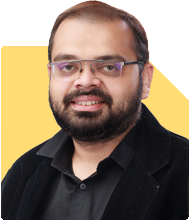Daughter Studying Smart Manufacturing: Best GATE Subject for M.Tech AI & ML?
Rajesh Kumar Singh | Answer |Ask -Follow
IIT-JEE, GATE Expert - Answered on Mar 06, 2025
During his career, he has served as the head of the mining department and as vice president of Balasore Alloys. He is currently a visiting professor at Mewar University where he teaches BTech students.
Rajesh Kumar topped his batch in BTech mining from BIT, Sindri.
A gold medallist, he has cracked the GATE (Graduate Aptitude Test in Engineering) twice -- in 1993 and 1994 -- with an All India Rank of 14 in 1994.
He has also cleared the Indian Institute of Corporate Affairs (IICA) Independent Director Test.... more

My daughter is studying B.Tech Smart Manufacturing. Which subject in GATE exam is best suitable for her to purse M.Tech AI & ML?
You may like to see similar questions and answers below
Kasam Shaikh | Answer |Ask -Follow
AI Tech Expert - Answered on Jul 15, 2024
Patrick Dsouza |1429 Answers |Ask -Follow
CAT, XAT, CMAT, CET Expert - Answered on Jun 25, 2024
Nayagam P P |10859 Answers |Ask -Follow
Career Counsellor - Answered on Mar 28, 2025
Prof Suvasish Mukhopadhyay | Answer |Ask -Follow
Career Counsellor - Answered on Jun 28, 2025
Ramalingam Kalirajan |10908 Answers |Ask -Follow
Mutual Funds, Financial Planning Expert - Answered on Dec 20, 2025
Ramalingam Kalirajan |10908 Answers |Ask -Follow
Mutual Funds, Financial Planning Expert - Answered on Dec 20, 2025
Naveenn Kummar |237 Answers |Ask -Follow
Financial Planner, MF, Insurance Expert - Answered on Dec 20, 2025
Ramalingam Kalirajan |10908 Answers |Ask -Follow
Mutual Funds, Financial Planning Expert - Answered on Dec 19, 2025
Nayagam P P |10859 Answers |Ask -Follow
Career Counsellor - Answered on Dec 19, 2025
Ramalingam Kalirajan |10908 Answers |Ask -Follow
Mutual Funds, Financial Planning Expert - Answered on Dec 19, 2025
Ramalingam Kalirajan |10908 Answers |Ask -Follow
Mutual Funds, Financial Planning Expert - Answered on Dec 19, 2025
Ramalingam Kalirajan |10908 Answers |Ask -Follow
Mutual Funds, Financial Planning Expert - Answered on Dec 19, 2025
Radheshyam Zanwar |6751 Answers |Ask -Follow
MHT-CET, IIT-JEE, NEET-UG Expert - Answered on Dec 19, 2025
Radheshyam Zanwar |6751 Answers |Ask -Follow
MHT-CET, IIT-JEE, NEET-UG Expert - Answered on Dec 19, 2025



























